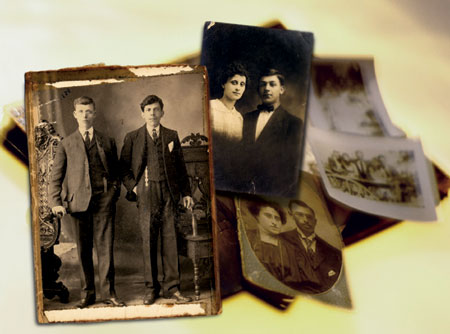Back

Professional photography greats like Luke Swank and Teenie
Harris went to great lengths to preserve the products of
their labor. (See articles on pages 16 and 34.) Decades
later, the digital revolution has made the storing and
preservation of photo images a no-brainer. But the baby-boomer
generation and the generations before it didn’t have
the luxury of storing lifelong memories on disk. Most are
in boxes or photo albums—storage methods that are
hardly fool-proof, a point made painfully clear after the
recent flooding of New Orleans.
Since the birth of photography in 1839 and the invention
of the daguerreotype (the first commercially used photographic
process), people around
the world have been enthralled with photography’s
ability to preserve the moment. And for almost as long,
people have been anxious to protect their photographs and
the personal memories and history they represent.
Bernadette
Callery, museum librarian for Carnegie Museum of Natural
History, explains that every type of photograph
is a complex interaction of material, surfaces, and development
processes—and all are “intrinsically fragile.” And
regardless of their age and type, they have a common enemy—deterioration.
If your photos are in good condition and you’d like
to keep them that way, experts agree that you need to keep
several factors in mind: storage materials, environmental
conditions, and handling.
The Steps to Preservation
According to Miriam Meislik, archivist/ photograph curator
at the University of Pittsburgh, you don’t need
to be an expert to protect photographs—you simply
need to use care. “Certain types of photographs,
such as ‘albumin’ prints from the 1880s to
1890s, have special storage requirements,” says
Meislik. “Since most people don’t know what
types of photos they have, I recommend sticking with
the most conservative storage methods that will work
for all types of paper photographs.”
1. Choose the Right Storage Materials
Meislik says the Internet has opened up a world of materials
and information that formerly was available exclusively
for conservators and librarians. For instance, the same
materials that she uses for the University of Pittsburgh’s
collections are available to everyone at
a reasonable price. (See resources at end of article.)
Starting with albums and binders is fine, as long as you
use unbuffered, acid-free paper and photo corners, and
never use adhesives or “magnetic” photo album
pages. Both buffered and unbuffered paper is available,
and either would be fine. Meislik opts for unbuffered paper
as a general rule because some types of older photos require
it. As an alternative, polypropylene, polyethylene, or
Mylar sleeves or pages are fine, but again, she warns that
all plastic sleeves are not photo safe. “Be sure
you know what you’re buying before using clear sleeves,” she
warns.
If you want to store your photos in boxes, you’ll
again need to choose the right materials. Your photos can
be wrapped or separated by unbuffered, acid-free paper
and stored in special photo-safe boxes that are sold in
an array of sizes. To avoid crumbling or cracking, never
stack fragile photos on top of one another. They should
be individually wrapped and supported, if necessary, by
more of the same paper, before placing them in your photo-safe
boxes.
2. Choose the Right Environment
Humidity, heat, and light are the enemies of photo prints
and negatives, so you’ll
want to avoid the attic and the basement. An ideal spot
is a dark closet shelf on an interior wall of the house,
where your photos will be safe
under dry, dark, relatively cool conditions. “Please
do not put mothballs
in with your photos!” says Meislik, who has seen
many photographs ruined by the strong chemicals. “Don’t
even be tempted!”
3. Handle Your Photos With Care
When it comes to handling your photographs, abide by the
the adage “less is more.” Hold photos by the
edges to avoid getting oil or dirt on the surface. If your
photos are extremely old or valuable, you may even want
to go “pro” and wear white cotton gloves.
After the Flood
Here’s what Callery recommends in the immediate aftermath
of water damage:
- Use both hands to support wet photographs,
as they are fragile.
- Rinse off mud with clean water, but
avoid touching the image surface.
- Lay your photos in a single layer on a clean flat surface
and allow them to air dry. Avoid exposing them to
direct sunlight.
- Photos that are stuck together should be rinsed
with clean water, then sealed in a zipper type plastic
bag
and placed in the freezer. At a later time, your
frozen photographs
can be defrosted, separated, and air dried.
Advice for Old Photos: Consult the Experts
If you have old photographs in frames or older photographs
such as daguerreotypes or ambrotypes in their telltale
decorative cases, resist the urge to open them. “The
best advice is to leave them alone if they seem okay,” says
Meislik.
Framed photographs, especially those without
a mat or space between the glass and the photo, can get
stuck to the glass
and tear when you try to remove them. In addition, Meislik
explains that the decorative cases of ambrotypes and daguerreotypes
help to seal out moisture and dirt.
If you want to clean these photos, she recom- mends that
you take them to an experienced conservator rather than
attempting any cleaning yourself. And you’d be wise
to follow the same advice for any damaged or deteriorating
photos.
If you don’t know where to find a professional
conservator, send an email to Miriam Meislik for guidance:
miriam@pitt.edu.
Online Resources
To Purchase Photo-Safe Storage Materials:
www.lightimpressionsdirect.com
Care
of Photographs:
www.nedcc.org/p101cs/lesson7.htm#sec5
www.pitt.edu/~olcpwg/
www.nedcc.org/leaflets/phocar.htm
Identifying Types of Photographs:
www.nedcc.org/leaflets/photype.htm
Descriptions and Examples of Photo Types:
imsc.usc.edu/haptics/LostandFound/terms.html
Salvaging Water-Damaged Valuables:
www.heritagepreservation.org/programs/tftips.htm.
Back
| Top |